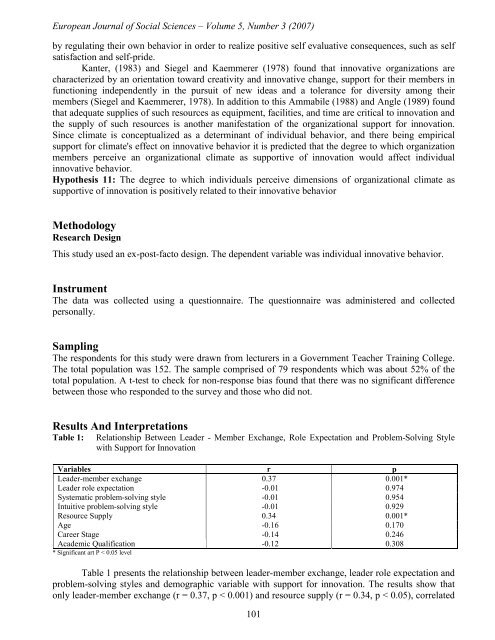european journal of social sciences issn: 1450-2267 - EuroJournals
european journal of social sciences issn: 1450-2267 - EuroJournals
european journal of social sciences issn: 1450-2267 - EuroJournals
Create successful ePaper yourself
Turn your PDF publications into a flip-book with our unique Google optimized e-Paper software.
European Journal <strong>of</strong> Social Sciences – Volume 5, Number 3 (2007)<br />
by regulating their own behavior in order to realize positive self evaluative consequences, such as self<br />
satisfaction and self-pride.<br />
Kanter, (1983) and Siegel and Kaemmerer (1978) found that innovative organizations are<br />
characterized by an orientation toward creativity and innovative change, support for their members in<br />
functioning independently in the pursuit <strong>of</strong> new ideas and a tolerance for diversity among their<br />
members (Siegel and Kaemmerer, 1978). In addition to this Ammabile (1988) and Angle (1989) found<br />
that adequate supplies <strong>of</strong> such resources as equipment, facilities, and time are critical to innovation and<br />
the supply <strong>of</strong> such resources is another manifestation <strong>of</strong> the organizational support for innovation.<br />
Since climate is conceptualized as a determinant <strong>of</strong> individual behavior, and there being empirical<br />
support for climate's effect on innovative behavior it is predicted that the degree to which organization<br />
members perceive an organizational climate as supportive <strong>of</strong> innovation would affect individual<br />
innovative behavior.<br />
Hypothesis 11: The degree to which individuals perceive dimensions <strong>of</strong> organizational climate as<br />
supportive <strong>of</strong> innovation is positively related to their innovative behavior<br />
Methodology<br />
Research Design<br />
This study used an ex-post-facto design. The dependent variable was individual innovative behavior.<br />
Instrument<br />
The data was collected using a questionnaire. The questionnaire was administered and collected<br />
personally.<br />
Sampling<br />
The respondents for this study were drawn from lecturers in a Government Teacher Training College.<br />
The total population was 152. The sample comprised <strong>of</strong> 79 respondents which was about 52% <strong>of</strong> the<br />
total population. A t-test to check for non-response bias found that there was no significant difference<br />
between those who responded to the survey and those who did not.<br />
Results And Interpretations<br />
Table 1: Relationship Between Leader - Member Exchange, Role Expectation and Problem-Solving Style<br />
with Support for Innovation<br />
Variables r p<br />
Leader-member exchange 0.37 0.001*<br />
Leader role expectation -0.01 0.974<br />
Systematic problem-solving style -0.01 0.954<br />
Intuitive problem-solving style -0.01 0.929<br />
Resource Supply 0.34 0.001*<br />
Age -0.16 0.170<br />
Career Stage -0.14 0.246<br />
Academic Qualification -0.12 0.308<br />
* Significant art P < 0.05 level<br />
Table 1 presents the relationship between leader-member exchange, leader role expectation and<br />
problem-solving styles and demographic variable with support for innovation. The results show that<br />
only leader-member exchange (r = 0.37, p < 0.001) and resource supply (r = 0.34, p < 0.05), correlated<br />
101

















